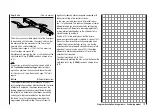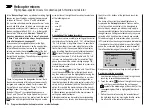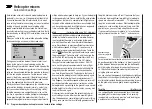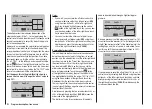
119
Program description: helicopter mixers – model helicopter
Adjusting the gyro sensor
If you wish to set up a gyro to achieve maximum pos-
sible stabilisation of the helicopter around the vertical
axis, please note the following points:
The mechanical control system should be as free-
•
moving and accurate (slop-free) as possible.
There should be no “spring” or “give” in the tail rotor
•
linkage.
You must use a powerful and - above all - fast servo
•
for the tail rotor.
When the gyro sensor detects a deviation in yaw, the
faster it adjusts the thrust of the tail rotor, the further the
gyro gain adjuster can be advanced without the tail of
the model starting to oscillate, and the better the ma-
chine’s stability around the vertical axis. If the corrective
system is not fast enough, there is a danger that the
model’s tail will start to oscillate even at low gyro gain
settings, and you then have to reduce gyro gain further
using the rotary proportional control CTRL 8, as used
in our example, to adjust the pre-set “Gyro” value to
eliminate the oscillation.
If the model is flying forward at high speed, or hovering
in a powerful headwind, the net result of the stabilising
effect of the vertical fin combined with the gyro’s stabilis-
ing effect may be an over-reaction which manifests itself
as tail oscillation. In order to obtain optimum stabilisation
from a gyro in all flight situations, you should make use
of the facility to adjust gyro gain from the transmitter.
inp8
(Input 8)
Ch1
Ch1
ptch
thro
tail
normal
gyro
0%
inp8
0%
The adjustment facilities in this line of the menu are only
relevant if your model helicopter is fitted with a speed
governor (regulator) which maintains a constant system
rotational speed, and you wish to control it using the
“classic” method. The settings should then be entered
in accordance with the instructions supplied with the
governor you intend to use.
However, it is more convenient - and also safer - to
adopt the method described on the preceding double-
page, using the “Ch1
thro” mixer.
Swashplate limiter
Ch1
Ch1
thro
tail
normal
gyro
0%
inp8
0%
swash lim.
off
This function acts like a circular mechanical gate acting
upon the swashplate control stick, restricting its range
of travel - which is usually rectangular - to a circular
pattern. This is designed to solve the following problem:
if the helicopter is set up in such a way that the roll and
pitch-axis travels extend to the maximum possible in
mechanical terms, e. g. for 3-D helicopter flying, then at
simultaneous full travel of roll and pitch-axis the actual
movement of the swashplate is higher (theoretically
141%). In this situation the mechanical swashplate sys-
tem may strike its end-stops, and in the extreme case
the ball-links may even be forced off the linkage balls.
In the
mx-16
HoTT transmitter a software function has
the effect of limiting the overall swashplate travel, i. e. the
tilt angle of the swashplate between 100% (the travel
is limited to the value which can be reached by one
function - roll or pitch-axis - alone) and 149% (no limiting
in force) is switched “off” (the function is completely
disabled). Swashplate limiting can also be adjusted to
suit individual models and flight phases.
This software solution is far more flexible than a physical
limiter disc attached to the stick unit, and such a disc
can only be used in any case if the roll and pitch-axis
functions are controlled by one of the two primary sticks.
The sketch alongside shows the effect of the limiter at a
setting of 100%: the dotted
area of travel is cut off, and
appears as a dead zone. If
this function is used, you
should leave “Dual Rate”
at 100%, and you should
not set Dual Rate values
greater than 100%, other-
wise travel will be limited on
the roll or pitch-axis individually if the swashplate limiter
is set to 100%.
Adjustment range: 100 ... 149% and “off”.
Summary of Contents for mx-12 Hott
Page 1: ...Programming Manual 33116 mx 16 HoTT 3 en mx 16...
Page 35: ...35 For your notes...
Page 49: ...49 For your notes...
Page 55: ...55 For your notes...
Page 59: ...59 For your notes...
Page 63: ...63 For your notes...
Page 69: ...69 For your notes...
Page 91: ...91 For your notes...
Page 101: ...101 For your notes...
Page 123: ...123 For your notes...
Page 181: ...181 For your notes...
Page 193: ...193 For your notes...
















































